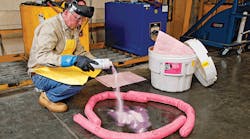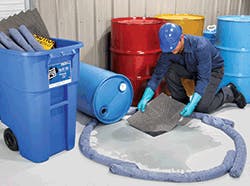When oil drips from a hose fitting onto the floor in a production area or a pan that was placed under a leaky drum faucet gets knocked over, workers who have been taught how to safely clean up after themselves often don't give a second thought to grabbing a handful of paper towels or an absorbent and taking care of the mess. Most wouldn't even consider these occurrences to be spills. But, are they just as comfortable cleaning up a 20-gallon or even a 100-gallon spill?
Responding to spills sometimes can present hazards that workers don't face on a daily basis, and not every spill as easily is tackled as the first two scenarios mentioned above. When is a spill just an incident requiring clean up or an emergency requiring a hazmat response?
Incidental or Emergency
Anyone who is tasked with cleaning up a spill needs to understand the hazards it presents and know what precautions need to be taken to safely clean it up. It doesn't matter if the spill is just a few ounces or if it is 100 gallons. A well-trained worker quickly will be able to assess a situation and know whether to take care of the spill or evacuate.
A first step for workers who could encounter a spill at a facility is to understand the difference between incidental and emergency spills. Incidental spills are the most-common type of spills facilities face. An incidental spill does not pose a substantial hazard to the worker or workers cleaning it up. These spills usually are small quantities of lower-hazard chemicals that do not have the potential to become an emergency in a short time frame.
Response to incidental spill response is not governed under OSHA's Hazardous Waste Operations and Emergency Response (HAZWOPER) Standard. Workers are not required to have a specified level or amount of training to clean up small, non-emergency spills – they just need to be able to recognize the hazards and be able to follow the prescribed plan that the facility has outlined to safely accomplish the task. Incidental spill response can be part of a facility's standard operating procedures, and training can be incorporated into hazard communication or other safety trainings.
By contrast, OSHA defines an emergency spill as one that causes unsafe exposure to a toxic chemical, requires workers to evacuate the area, poses immediately dangerous to life and health conditions, presents a fire or explosion hazard or requires other immediate attention because of danger. HAZWOPER regulations outline the levels of training that are required to help emergency spill personnel stay safe during a response. In addition to initial training ranging from 8 to 40 hours, annual refreshers are required to maintain HAZWOPER certifications.
There is no one-size-fits-all answer as to whether a spill is an emergency or if it is incidental. The distinction must be made by the facility, based on training and other factors. In an interpretation letter, OSHA clarifies that "the quantity of product spilled does not by itself determine if an incidental spill has occurred. Several variables must be considered. Examples of other variables include the type of material spilled and the location of the spill."
It usually isn't practical to train everyone to be part of the facility's emergency spill response team. But everyone should have an understanding of what types of liquids could spill and know what to do when there is a spill. In some cases, response primarily could be based on volume; in others, the type of liquid may have a heavier weight than the volume of the spill. Still others may base it on the location of the spill. Most often it is a combination of these factors. Whatever strategy is chosen, it must be understood by everyone.
Hazard Potential
Any spill can be hazardous. For example, water from a wet umbrella that drips onto a highly polished floor is enough to cause a slip-and-fall hazard. Although it definitely should be cleaned up as soon as it is discovered to prevent a potential injury, the water on the floor typically would not meet the definition of an emergency spill, and the hazmat team would not be needed to take care of the situation.
Now, consider just a few drops of mercury that roll into a corner of a college laboratory. The total volume spilled roughly is the same as the drops of water from the umbrella, and no one is going to slip on it because it's not in a walking path. But, this situation is different because mercury vapors are toxic. This means that the spilled mercury poses significant health hazards to anyone in the vicinity and to those who will clean it up. This spill is best left for a well-trained response team.
Facilities perform hazard evaluations and risk analyses on chemicals and processes so that they can establish procedures that properly protect workers from routine hazards. Expanding these evaluations to include an understanding of whether or not hazards change, or if standard handling procedures become unsafe when a chemical has spilled, helps to form a basis for training workers to either respond to those spills or to evacuate.
Circumstances
The properties of liquids stored and used onsite are variables that workers need to understand when they encounter spills – especially when they deal with hazardous liquids every day. It can be easy to forget the specific hazards of liquids if you work with them every day. It also can be easy to think that if a liquid is used in one area or process safely that handling a spill of it should be safe to do anywhere.
The location of a spill can be an important consideration. A 5-gallon spill of solvent from a parts washer in a large, open production area certainly is going to be inconvenient and possibly could disrupt production schedules while workers take time to clean it. But that spill still may be considered incidental if it doesn't pose an immediate threat to worker safety, and if it isn't entering an unprotected floor drain, potentially causing environmental pollution if the spill is not contained.
There is no one-size-fits-all answer as to whether a spill is an emergency or if it is incidental.
A 5-gallon spill of the same solvent in a basement with poor ventilation or in a confined space quickly could become an emergency if flammable vapors build up in either of the areas. Even though the liquid and volume spilled are the same in the parts washer scenario and in the other two situations, the way to safely respond to each spill is different because the circumstances have changed.
Even well-trained workers who are members of a facility's hazmat team will consider the circumstances before rushing to clean up a spill. They certainly will account for the properties of the liquid and the volume that has spilled and the location. And they also will consider what spill response tools and types of personal protective equipment (PPE) are available for their use. If the correct tools and PPE are not available, it may not be safe to begin or continue spill response efforts.
Training
Incidental or emergency, the first priority of spill response always is life safety. Giving workers a complex list of scenarios to determine if a spill is incidental or if it is an emergency is confusing and delays response. The decision process needs to be clear and easy to understand.
In some facilities, the rule is: if you can step over the spill, you can clean it up. If you can't, evacuate and call the emergency response team. This may be overkill for some spills, but it is easy to understand and helps keep everyone safe.
It may seem like an easy solution to train everyone to be an emergency responder, but that can be an expensive and time-consuming option, especially for facilities that don't have a wide variety of chemicals. It also may be unwarranted, considering that the worst-case scenario – emergency spills – aren't common in most facilities. Incidental spills are far more common.
Another seemingly easy option is to treat everything as an emergency and have everyone evacuate the area any time there is a spill. This minimizes training needs, but can cause excessive downtime while the hazmat team assembles and responds. It also can cause unnecessary stress for workers if they are given the impression that everything they work with on a daily basis is so toxic that they can't be in the same room with it.
Increasing workers' knowledge of the chemical hazards that they face every day and providing clear direction on how and when to clean up incidental spills will enable workers to make incidental response part of their daily routines. When this is balanced with the understanding that it's okay to call in emergency responders if they are uncomfortable or unsure about clean up, spills can be handled efficiently and safely.
Karen D. Hamel is a technical specialist for New Pig Corp. She has over 20 years of experience helping environmental, health and safety professionals find solutions to meet EPA, OSHA and DOT regulations. She is a hazmat technician, serves on the Blair County, Penn., LEPC, is a CERT trainer and has completed a variety of hazmat response and NIMS courses, including planning section chief. She can be reached at 1-800-HOT-HOGS® (468-4647) or by email at [email protected].

